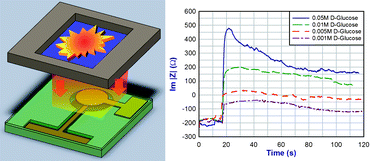Monitoring biochemical reactions using Y-cut quartz thermal sensors
Abstract
In this paper, we present a micromachined Y-cut

* Corresponding authors
a
Department of Electrical Engineering, The Pennsylvania State University, University Park, PA, USA
E-mail:
sat10@psu.edu
Fax: +1 814 865 7065
Tel: +1 814 865 2730
In this paper, we present a micromachined Y-cut

 Please wait while we load your content...
Something went wrong. Try again?
Please wait while we load your content...
Something went wrong. Try again?
K. Ren, P. Kao, M. B. Pisani and S. Tadigadapa, Analyst, 2011, 136, 2904 DOI: 10.1039/C1AN15153C
To request permission to reproduce material from this article, please go to the Copyright Clearance Center request page.
If you are an author contributing to an RSC publication, you do not need to request permission provided correct acknowledgement is given.
If you are the author of this article, you do not need to request permission to reproduce figures and diagrams provided correct acknowledgement is given. If you want to reproduce the whole article in a third-party publication (excluding your thesis/dissertation for which permission is not required) please go to the Copyright Clearance Center request page.
Read more about how to correctly acknowledge RSC content.
 Fetching data from CrossRef.
Fetching data from CrossRef.
This may take some time to load.
Loading related content
